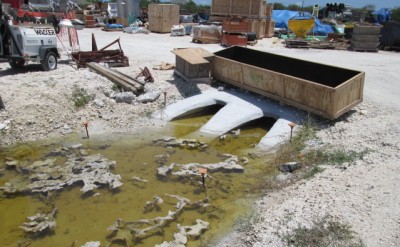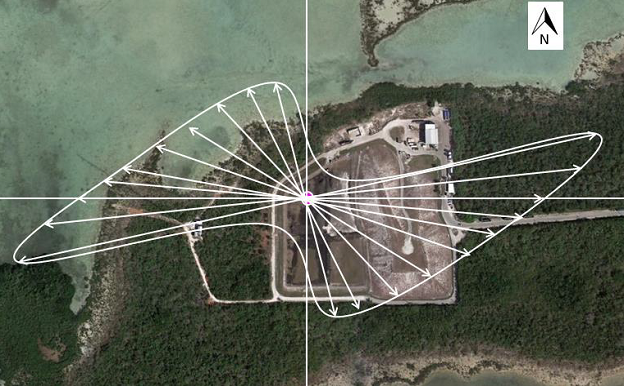“THE DRAGON UNDER THE LANDFILL”: Sanctuary Experts Say Don’t Use Shallow Wells at Cudjoe Regional
BREAKING NEWS….
The South Florida Conservation Director of The Nature Conservancy and two eminent Florida Keys National Marine Sanctuary scientists called on the BOCC to delay using the shallow wells at the Cudjoe Regional Wastewater plant.
Describing the current system of septic tanks as the devil we know, The Nature Conservancy’s Chris Bergh told the Board of County Commissioners at its meeting on May 20, 2015, “The devil we know is better than the devil that we don’t know…based on these studies the AWT [effluent] is going to come up….There will be an impact on the environment…go for now with the devil that we do know and do not inject wastewater into these shallow wells.”
Instead of going to court, Dr. Briceno told the BOCC “you must make sure we have an ecological assessment of Cudjoe Key we can use for evaluating potential impacts”.

Expanding on Mr. Bergh’s comments, Dr. Henry Briceno explained: “We are in a situation that we have to select from bad or worse. The well-known devil is that of the septic tanks which have crippled water quality in canals and marine waters close to shore for years, with not only nutrient and fecal matter, but with chemicals of all kinds…….We do not know for certain how the biodiversity and water quality is already impacted from those juices coming out of the unlined landfill. In what conditions are the fisheries, mangrove forests and seagrasses around the treatment plant? What would be the added damage? Will the system go beyond the point of no return? .. We simply do not know,… This is the unknown devil, the dragon under the landfill.”
Speaking as a member of the scientific community, Dr. Briceno described what he learned by performing the tracer-dye study for FKAA at Cudjoe Regional. “We know that if we inject water in those shallow wells it will boomerang back to the surface. That’s a fact. And those waters are going to interact with whatever is on the surface environmental conditions…which unfortunately on Cudjoe Key we don’t know.” Dr. Henry Briceno also serves at the Principal Investigator for the Florida Keys National Marine Sanctuary’s Water Quality Monitoring project.
Dr. Jim Fourqurean, speaking as a member of the scientific community, described the impact of the freshwater AWT effluent in the Florida Keys marine environment: “We know that phosphorous will be liberated from the rock if we pump all this fresh water down into the subsurface. We know that the phosphorous is going to come to the surface. We know that if you put any phosphorous in the water anywhere in south Florida you …change the conditions of the turtle grass and corals that we value in south Florida. Dr. Fourqurean also pointed out that although the effluent is treated to Advanced Wastewater Treatment standards (AWT), it still has 100 times more phosphorus than nearshore waters, even before it liberates phosphorus from the subsurface limestone.
Dr. Fourqurean continued: “You are taking a system of bad septic tanks that is distributed across the entire region. You’re collecting it into a single point source, you are concentrating the problem. Although septic tanks are bad, shallow well injection could create much worse problems at this point source on Cudjoe Key than we’re now generating.” Dr. Fourqurean also serves as the Principal Investigator for the Florida Keys National Marine Sanctuary’s Seagrass Monitoring project.
Asked by Mayor Kolhage to explain why DEP has been permitting shallow wells, Dr. Fourqurean replied, “I think they are looking at the wrong rules….The standards actually say that the discharges must not cause an imbalance in the flora and fauna of outstanding Florida waters. We know that if you put any phosphorus in the water anywhere in South Florida you create an imbalance.”
Dr. Briceno urged the BOCC to speed up the deep well. “… whatever you decide, … you must speed up the dream of that deep well. Bring an oil company that can drill more than 3,000 feet in two months or less. And try to make the permitting agencies speed up their processes. ….We cannot wait 2½ years.”
In July, 2014, The Cudjoe Gardens and Sugarloaf Shores property owners associations, representing approximately 500 property owners, and Mike Laudicina and Don DeMaria, local commercial fishermen, challenged the FDEP draft permit which allows FKAA to operate Cudjoe Regional using only shallow wells. Although FKAA agreed in March, 2015, to build a deep well, FKAA intends to use the shallow wells during the 2 years or more FKAA predicts it will take to build the deep well. FKAA predicts it will dispose of 300,000 gallons per day in one year, and 550,000 gallons in two years. The legal challenge continues. “Don’t flush the dump,” said Larry Francisco, President of Cudjoe Gardens Property Owners Association.
Click here to view Dr. Henry Briceno’s written statement..
To view the video of this part of the BOCC meeting, go to https://dl.dropboxusercontent.com/u/66876295/BOCC_ITEM_O_11_20150520_VOD.WMV?dl=1
DID YOU LIKE THIS STORY? SUPPORT THE BLUE PAPER
Help us continue to bring you local investigative journalism… Click on the image to make a donation [NOT tax deductible].





Excellent article!
It is so refreshing to see doctoral experts in the scientific community and a spokesman for a national conservation organization admit that septic tanks (even with some unarguably unacceptable cesspits in the mix) are preferable to an ill-conceived central sewer system.
FKAA was warned by DEP in 2008 that they would need at least one deep well and that they might migrate landfill leachate if they used shallow wells. Instead of heeding the warning, FKAA cut a deal with DEP to let them try to get by with shallow injection for a short while.
FKAA then designed and built an undersized plant that made NO provision for a deep well EVER. That was way beyond irresponsible.
Now, seven years later, we have a substantially complete $19 million treatment plant that is legally unusable. “Nice work, FKAA executives!” says their Board as they pass out huge raises and a big promotion. Daft.
Right now, the County can blame the whole boondoggle on FKAA, knowing that the Governor will not punish the County for the ineptitude or arrogant malfeasance of his “special district” that answers only to him. Based on the BOCC comments, it looks like the County will instead defend FKAA, and thus soon become willfully in violation of federal environmental regulations. We may not have to wait for the seriously faulty Cudjoe Regional sewer collection system to overflow before this central sewer system makes headlines outside of the Keys. Stay tuned.
The usual plan of attack for most government agencies(FKAA included) is Damn The Torpedoes Full Speed Ahead. And when the poop hits the spinning blades, issue the usual lame excuse, apologize, have the Taxpayers(customers) pay the fine, & continue on as nothing happened. Now as the situation continues worsen and evidence if a serious environmental catastrophe is on the doorstep mounts does Kurt Zeulch have the cajones to Flip The Switch? and plead The Mandate? And where are the regulators?? They’re having their attorneys searching for loopholes so they can claim innocence. As the water drips.
I and my wife are five-year residents of Cudjoe Acres, the low lying area of homes that are on the other side of Blimp Road near the waste transfer station.
Here is something we witness more frequently with each passing year: rising sea levels flooding two of our three access roads (Spain and Valencia Roads) more and more with salt water.
This salt water comes from the salt ponds or marsh’s on either side of Blimp Road at high tides. Add in heavy rainfall, and sometimes Spain Road is underwater with fingerlings (small baby fish) swimming across the road in our headlights.
Our first year up here, Spain Road flooded maybe three times. Last year, the same road was under salt water at least 15 times – and this is with a new layer of gravel on top of the road.
To better see this phenomenon, ride the new bicycle path that runs parallel to US 1 up this way during a high tide. Or walk it in a heavy rain. This bike path cuts along State Road 4A (I believe that’s the name of the road that runs parallel to US 1). On high tides, sea water spreads across the brand new bike path pavement in many areas. From Blimp Road’s crossing down to where the bike path crosses over US1 (below the Cudjoe Sheriff’s sub-station) this new bike path repeatedly floods with water that surrounds the Cudjoe Waste Disposal plant.
Another easy way to witness sea level rise is to drive down to the end of Blimp Road at high tide. Down where the road ends in a boat ramp, you’ll see “weed lines” which have come up with the sea water on both sides of Blimp Road.
These weed lines – with sea water behind them – already push beyond the parking shoulders on both sides of the road. Indeed, I have witnessed time and again, boaters and kayakers coming back to the boat ramp to get into their trucks at high tide. To access their vehicles, they must walk through sea water to open their doors. All of the vehicle’s tires are in sea water. The boat trailer’s tires are in sea water. Meanwhile, the weed lines creep ever closer to one another from both sides of this road. In another ten years, I predict these weed lines will meet on the center lines of the road.
With shallow well injection, these people will be walking through treated sewage water that is collected and “stored” in one central location and which leaches back into the water surrounding the plant. This polluted water will spread into the salt ponds and the bay and ocean side waters. The Blimp Road boat ramp waters is where 19 beached pilot whales were once attended to in our first or second year as residents in Cudjoe Acres. I can no longer imagine this would be a good staging area for future rescues of sea mammals, can you?
The sea water in these shallows is where people go crabbing, fishing, kayaking, swimming, boating, throwing sticks and tennis balls to their dogs and playing with toy hobby boats. I can no longer imagine any fishermen or crabbers wanting to eat anything out of these waters once the shallow injection wells begin use. (I no longer fish from the Sugarloaf Bridge near KOA because of the nearby waste refuse plant leaching pollutants into our waters.)
As your article points out, dye tests have already shown shallow well water is soon back up on the surface. Keep in mind these surface waters sluice through pipes under Blimp Road. They spread into the water at the end of Blimp Road. They spread to the outgoing tide under the Sugarloaf Bridge and around the homes on the other side of Cudjoe behind the Sheriff’s sub-station.
As the two good scientists have just pointed out, these newly collected waters will have 400x the normal phosphorous content of today’s runoff mixed in with treated sewer effluvia. We can read Army Corps of Engineer reports how fertilizer runoff containing high traces of phosphorous has turned areas of the Gulf of Mexico and Florida Bay into “Dead Zones”. Mix in treated sewage and one can only imagine the effect this will have on life around the shallow wastewater wells.
This, my friends, is what we are about to do with shallow well injection at the waste disposal plant: turn the Cudjoe and Sugarloaf basins into one giant toilet bowl.
Scientists are warning us. Mother Nature is warning us. Is anyone listening?
p.s. Try selling your land or house out this way once Scientists begin collecting pollution data. Try selling a potential buyer who reads about sea level rise and how it is taking over our roads and bike path. Try making a case to your spouse why you want to improve your yard when the fauna and flora are dying off.
We are living on borrowed time with sea level rise rising exponentially now. It is not only coming up over the roads, but from underneath, through porous limestone which resembles Swiss Cheese. But that’s another story for another article.
Correction: I should point out these shallow well waters would have 100x, not 400x (as I said above), the amount of phosphorous of near shore waters.
Still, I can see where Mote Marine Laboratory will have to expand it’s coral growth program with this rush by the FKAA to pump ATW into shallow wells.
A friend of mine on Motley Fool just published a link to an incredible overview of our Earth’s oceans.
This presentation, with one photo of diminishing fish catch from a certain boat in Key West’s Garrison Bight (watch the video, I refuse to give away the name), is a real eye opener. You will come away from this video knowing how badly mankind has killed off sea life through 1)overfishing, 2)pollution and 3)Climate Change.
Dr. Jeremy Jackson gives this speech before the United States Naval War College. According to the officer introducing Jackson, this would be his second speech he’s given them over the years. You can hear how appreciative and jazzed these fighting men of our Navy – along with ambassadors and other dignitaries – are by the absolute hush that falls over this crowd when Jackson begins his point and click presentation.
This video of Jackson’s presentation is a little over one hour, twenty-eight minutes long. It is worth seeing in its entirety. Some of the photos of coral bleaching remind me of once pristine reefs I visited in 1990 when I first arrived in the Keys, but which now look like bombed Palmyra ruins after ISIS has rolled through.
Grab a giant cup of freshly brewed coffee. Prepare to have your senses and mind assaulted.
https://www.youtube.com/watch?v=2zMN3dTvrwY